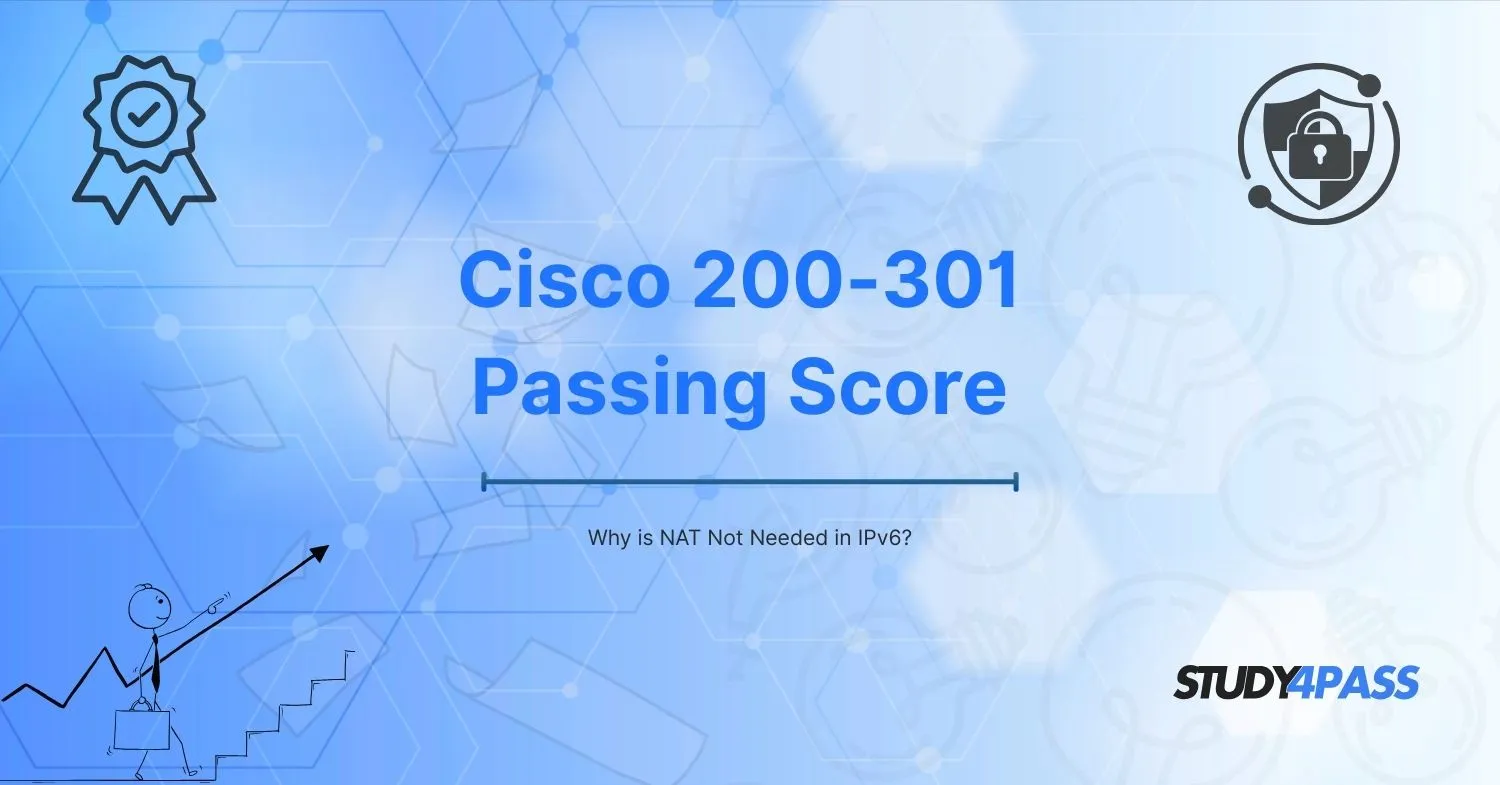Introduction To Cisco 200-301 Passing Score
In the world of networking, IPv6 was introduced to overcome the limitations of IPv4, particularly its limited address space. One of the most significant changes with IPv6 is the elimination of Network Address Translation (NAT), a common technique used in IPv4 to conserve addresses.
If you're preparing for the Cisco 200-301 Passinmg Score, understanding IPv6 and why NAT is unnecessary is crucial. At Study4Pass, we help you grasp these networking concepts to ensure you achieve the Cisco 200-301 passing score.
Understanding NAT in IPv4
Network Address Translation (NAT) was introduced to extend the lifespan of IPv4 by allowing multiple devices on a private network to share a single public IP address.
Private vs. Public IPs: IPv4 has a limited pool (~4.3 billion addresses), so NAT was used to allow many devices to share one public IP.
NAT Types:
Static NAT: One-to-one mapping.
Dynamic NAT: Multiple private IPs share a pool of public IPs.
PAT (Port Address Translation): Many private IPs share one public IP using different ports.
Problems with NAT
- While NAT helped delay IPv4 exhaustion, it introduced complications:
- Breaks end-to-end connectivity.
- Increases complexity in peer-to-peer applications.
- Can cause performance overhead.
- Since IPv6 has a vastly larger address space, NAT is no longer necessary.
2. IPv6 Address Space: A Solution to IPv4 Limitations
IPv6 Address Structure
IPv6 uses 128-bit addresses, compared to IPv4’s 32-bit system. This allows for 340 undecillion (3.4 × 10³⁸) unique addresses enough for every device on Earth to have multiple IPs.
Example IPv6 Address: `2001:0db8:85a3:0000:0000:8a2e:0370:7334`
Simplified Notation: Leading zeros can be omitted, and consecutive zeros can be replaced with `::` (e.g., `2001:db8::8a2e:370:7334`).
No Need for Private Addresses
IPv6 eliminates the need for private addressing schemes (like IPv4’s `192.168.x.x` or `10.x.x.x`) because every device can have a globally unique address.
3. Why Doesn’t IPv6 Need NAT?
Reason 1: Enormous Address Space
- IPv6 provides enough addresses for every device, eliminating the need to share IPs via NAT.
- No Address Exhaustion: Unlike IPv4, there’s no shortage.
- Simpler Network Design: No need for complex NAT configurations.
Reason 2: End-to-End Connectivity
NAT breaks direct communication between devices. Cisco 200-301 Certification restores true end-to-end connectivity, which is essential for:
- VoIP and video conferencing
- Peer-to-peer (P2P) applications
- IoT devices
Reason 3: Security Without NAT
Some believe NAT provides security by hiding internal IPs, but NAT is not a security feature. IPv6 uses better methods:
- IPSec (mandatory in IPv6): Encrypts traffic end-to-end.
- Firewalls: Still required for filtering unwanted traffic.
4. How Does IPv6 Handle Privacy and Security?
- Temporary Addresses for Privacy
- IPv6 supports privacy extensions, where devices generate temporary addresses to prevent tracking.
- Built-in Encryption with IPSec
- Unlike IPv4 (where IPSec is optional), IPv6 requires IPSec support, ensuring secure communications.
- No More NAT-Induced Issues
- No port conflicts
- Easier VPN setups
- Better application compatibility
5. Common Misconceptions About NAT and IPv6
Myth 1: "NAT Provides Security"
Reality: NAT only obscures internal IPs. Real security comes from firewalls and encryption.
Myth 2: "IPv6 Doesn’t Need Firewalls"
Reality: Firewalls are still essential for filtering malicious traffic.
Myth 3: "IPv6 is Hard to Implement"
Reality: Modern networks and OSs fully support IPv6, making adoption seamless.
6. Preparing for the Cisco 200-301 Exam: Key IPv6 Topics
To achieve the Cisco 200-301 passing score, you must understand IPv6. Key topics include:
- IPv6 Addressing and Subnetting
- Global unicast addresses
- Link-local addresses
- Multicast and anycast
- IPv6 Configuration on Cisco Devices
- Static and dynamic (SLAAC, DHCPv6) addressing
- IPv6 routing (OSPFv3, EIGRP for IPv6)
- Transition Mechanisms
- Dual-stack (IPv4 + IPv6)
- Tunneling (6to4, ISATAP)
At Study4Pass, we provide structured study materials to help you master these topics and pass the Cisco 200-301 exam with confidence.
Conclusion
IPv6 eliminates the need for NAT by providing an enormous address space, restoring end-to-end connectivity, and improving security with built-in encryption. While NAT was a necessary workaround for IPv4, IPv6’s design makes it obsolete.
Special Discount: Offer Valid For Limited Time “Cisco 200-301 Exam Prep Practice Tests”
Sample Questions for Cisco 200-301 Exam Prep Practice Tests
Actual exam question from Cisco's 200-301 Exam
What is the minimum passing score required to earn the Cisco CCNA (200-301) certification?
A) 70%
B) 80%
C) 85%
D) Cisco does not disclose the exact passing score


